-
Posts
552 -
Joined
-
Last visited
-
Days Won
2
Content Type
Profiles
Forums
Blogs
Gallery
Events
Store
Posts posted by Gunner 1
-
-
Jim: Sorry about taking that one away from you. Question #18
Like Alexey Petrovich Maresyev, who was the subject of an earlier question, I was also a double amputee, but I was neither a fighter ace nor a Hero of the Soviet Union (HSU) during the Great Patriotic War (GPW). I joined the Army before the GPW and served with the 51st Perekopsk Rifle Division. Later I served with the Red Banner Baltic Fleet (KBF) and was generally credited with three to four 'kills'. I ended the war as a Major in the KBF. Schools in Leningrad and Minsk are named for me.
Gunner 1
0 -
-
The Cruiser Aurora. The monument is in St. Petersburg.
0 -
Kапитан Григорий Яковлевич Бахчиванджи - died testing the first Soviet rocket fighter, the БИ-1? He certainly was thinking 'outside of the box'! I have seen that face before but just can't place it and it is way past my bedtime. Gunner 1
0 -
Is the man Captain Alekseei Stepanovich Khlobystov who carried out three tarans (some reference say four) and died in aerial combat on 13 December 1943? Gunner 1
0 -
The reference to Shahov may be misleading to those using the Library of Congress transliteration rules as I am quite sure it would be 'Shakhov' rather than 'Shahov' (more commonly used in German transliteration of Russian).
0 -
KDVR: Is anything engraved on the reverse of the VC that you asked about in the initial posting of this thread? In early 2008 Hancocks produced 1,356 replica Victoria Crosses cast in bronze and hand finished in an original Hancocks' Victoria Cross case. They were sold for £385 plus postage. The reverse center of each cross had the name 'Hancocks' engraved along with the number of the cross.
Regards, Gunner 1
0 -
THE BATH, PENNSYLVANIA WORLD WAR I SERVICE MEDAL (REVERSE)
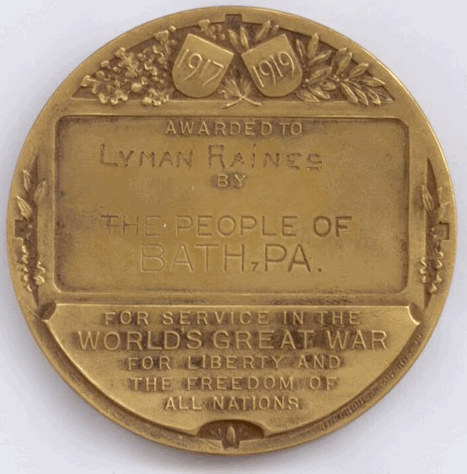 0
0 -
THE BATH, PENNSYLVANIA WORLD WAR I SERVICE MEDAL (OBVERSE)
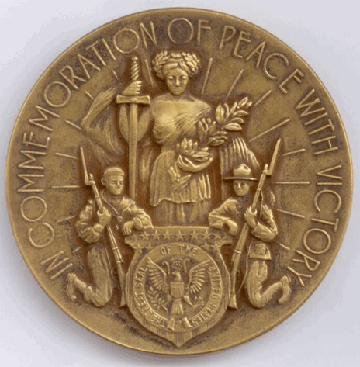 0
0 -
BIOGRAPHY OF JOHN WILBUR DICKEY, THE RECIPIENT
John Wilbur Dickey was born at Philadelphia, Pennsylvania on 1 April 1899, the son of John L. Dickey and Susan Buchanan Dickey of 2428 Christian Street, Philadelphia, Pennsylvania. Prior to World War I he was employed by the John Wanamaker Department Store in Philadelphia and was a senior cadet at the John Wanamaker Commercial Institute.
Dickey enlisted in the Pennsylvania National Guard on 19 June 1916, at the age of 17 years and 2 months and was posted as a Private (Army Serial Number 1251507) to A Battery, 2nd Field Artillery, Pennsylvania National Guard. He accompanied that unit to Texas on July 6, 1916 and served with it on Mexican border at Camp Stewart at El Paso, Texas until July 27, 1917. On July 12, 1917 he was promoted to Corporal and served at Camp Stancock, Georgia with his battery from August 27, 1917 until May 19, 1918.
Dickey was promoted to Sergeant on 1 January 1918 and embarked with his battery (now designated as Battery A, 108th Field Artillery, 28th Division) for France on June 5, 1918 and served with it in France until May 16, 1919. For his service in France he received the Victory Medal with four battle clasps: OISE-AISNE, YPRES-LYS, MEUSE-ARGONNE and DEFENSIVE SECTOR (this medal was not with the group when it was purchased). He returned home on May 23, 1919 and was honorably discharged at Fort Dix, New Jersey on 24 May 1919. After the war Dickey returned to employment with the John Wanamaker Department Store in Philadelphia and lived in Upper Darby, Pennsylvania. He died in May 1971.
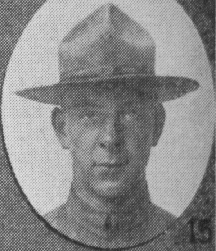 0
0 -
The reverse of the Wanamaker Medal for Mexican Border Service, 1916
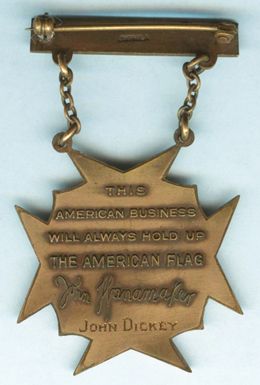 0
0 -
THE JOHN WANAMAKER MEDAL FOR MEXICAN BORDER SERVICE, 1916 AWARDED TO SERGEANT JOHN WILBUR DICKEY, 'A' BATTERY, 2ND FIELD ARTILLERY, PENNSYLVANIA NATIONAL GUARD
During 1916, 166 employees of the Wanamaker stores in Philadelphia and New York actively served on the Mexican Border. To honor this service John Wanamaker presented each of these employees with the John Wanamaker Medal for Mexican Border Service, 1916.
Description:
General: A bronze medal in the shape of a Maltese cross suspended by a chain from a bronze top bar.
Obverse: In the center a circle within which is a bust of John Wanamaker facing to his left. In the circle is the inscription: DEFENDER OF AMERICA MEMBER BUSINESS STAFF JOHN WANAMAKER . The circle is superimposed on the four arms of a Maltese cross. The upper arm bears the letter T; the others are blank. Between each arm of the cross is a sunburst with each having two letters superimposed: AU in the upper left, AC in the upper right, JW in the lower left, and CI in the lower right.
Reverse: In the upper half, the four line inscription: THIS / AMERICAN BUSINESS / WILL ALWAYS HOLD UP / THE AMERICAN FLAG. Below is the name JOHN WANAMAKER in script. At the bottom the name of the recipient JOHN DICKEY is engraved.
Suspension: The medal is suspended from a rectangular bronze top bar by a linked chain attached to a loop at each side of the bottom of the bar and to a loop at each end of the top arm of the Maltese cross. The obverse of the top bar has the words: MEXICAN BORDER 1916. The reverse of the top bar is blank except for the words J. W. PHILA. and a pin attachment with rotating safety clasp.
Reason for the award: The medal was awarded to the 166 employees of the John Wanamaker Department Stores who served on the Mexican Border in 1916. It appears that few of the 166 medals awarded have survived and that the medal is very seldom encountered.
The obverse of the medal is shown below:
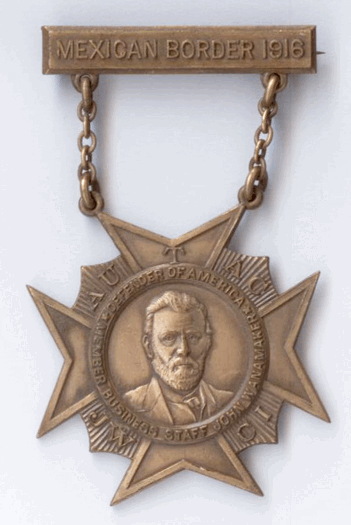 0
0 -
Tim: That is a good question. I have not seen Type I VMs except to officers and I have seen very few other than RA officers, but that may be due to my interest in RA officers. Gunner 1
0 -
And this pair with a Type I VM was issued to an RGA Captain on 14 October 1920.
 0
0 -
And other Type I VMs were issued in pair with a BWM; this one was issued to a Lieutenant, RFA on 30 November 1920.
 0
0 -
Most of the Type VMs to RA officers seem to be in groups that contain a 1914 Star, but some were issued in groups containing 1914-1915 Stars:
 0
0 -
A Type I VM (issued 16 November 1920) to a Captain, RFA:
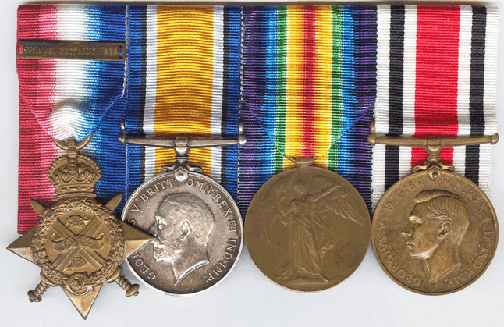 0
0 -
A 1914 Star group with Type I VM (issued 20 October 1920) to a Major, RFA:
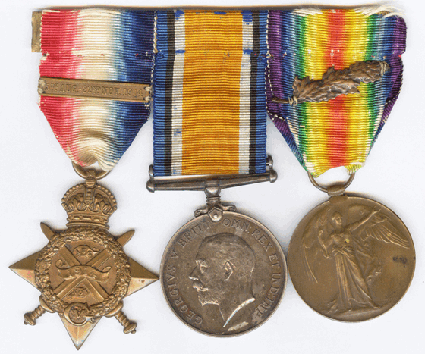 0
0 -
A 1914 Star group to a Captain, RFA. The Type I VM was issued on 7 October 1920.
 0
0 -
A 1914 Star group with Type 1 VM to a Major, RFA. The VM was issued on 3 November 1920.
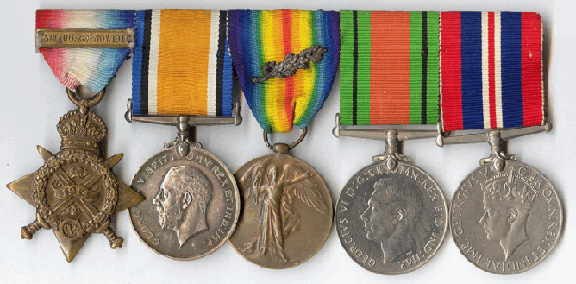 0
0 -
A QSA, 1914 Star group to Lieut., RFA with a Type I VM issued on 16 October 1920.
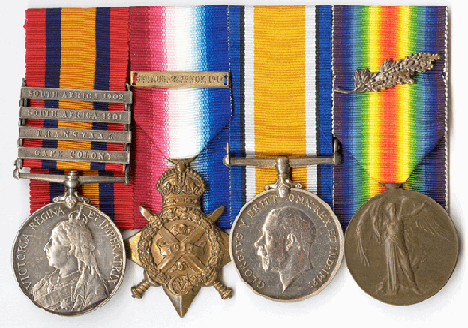 0
0 -
A DSO group to a Brigadier, RFA with a Type I VM. This VM was issued on 18 October 1920.
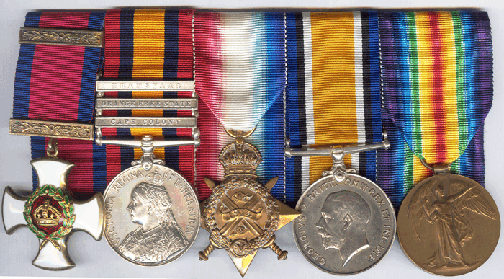 0
0 -
Tim: Many British dealers still do not recognize the Type I VM. I now have eight of them to RA officers and did not pay a premium for any of them. Gunner 1
0 -
Officer ranks on VMs and BWMs (5). From top to bottom: LT.COL.; BRIG.GEN. I would be interested in any comments. Regards, Gunner 1
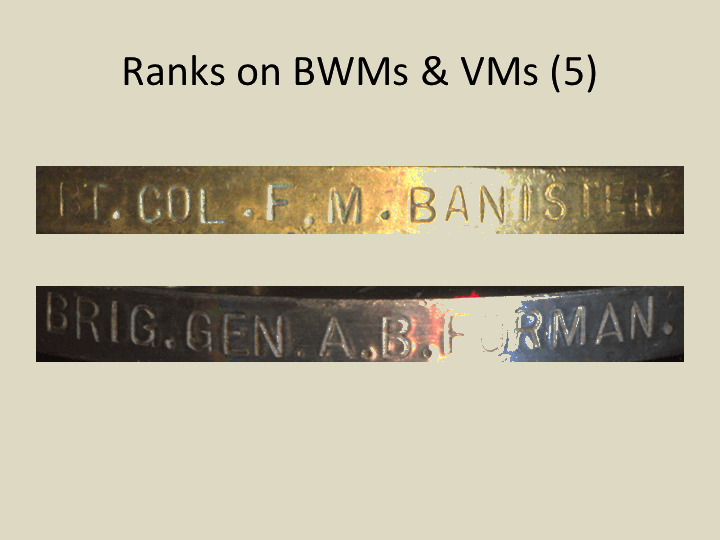 0
0




THE SOVIET QUIZ - 2011 - QUIZ CLOSED
in Russia: Soviet: Other Militaria
Posted · Edited by Gunner 1
Just so everyone is on the same page; I received the following personal conversation from a member :
. . . and my answer was:
Gunner 1